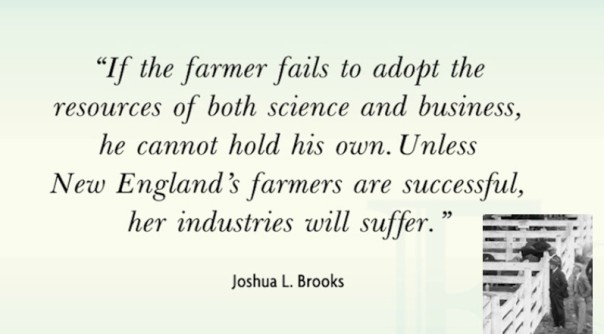View From Here: ESE CEO Gene Cassidy. . . And The Founder Of It All
Joshua L. Brooks was way ahead of his time. He had an idea that the best practices of agriculture and industry could be gathered up for an annual event that could draw all sorts of people to cross-pollinate knowledge. A place that could included amusement and entertainment, too. His tenacity turned that concept into reality. In 1916.

Gene Cassidy, ESE CEO and president, honors the past and looks out over a new era – the next 100 years – for Eastern States Exposition.
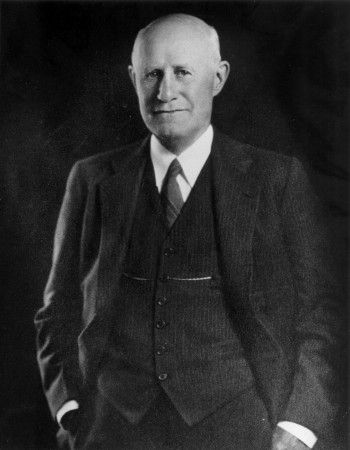
Joshua L. Brooks, founder and entrepreneur of what today is known as Eastern States Exposition.
“Brooks conceived of as a means where people could get together and exchange concepts for best practices,” said Gene Cassidy, president and CEO of Eastern States Exposition (ESE), which is the more concise name by which Brooks's idea is known by today. You may have heard of it, as ESE is non-profit parent corporation to the 17-day six-state New England Fair known better as The Big E, where in 2014 a record number of 1,498,605 visitors came through the gates. In 2016, ESE will mark its 100th year.
However, most people do not know the rest of the story. Let's step back a bit.

Gene Cassidy, CEO and ESE president, stands with a portrait that shows another view of Joshua Brooks, ESE founder.
Originally from Brookline in eastern Massachusetts, Brooks packed up and traveled to the western side of the state to open his own business as an engraver and has $1,400 with him to do so. “He finds a storefront in Springfield, and immediately commissions a beautiful gold leaf sign – The Brooks Bank Note Company – and spends the majority of the money he brought – for that sign and the space.” His confidence worked. Under Brooks's stewardship, his company prospered and grew to one of the biggest employers in Springfield. (And had longevity, as all eventually sold to the American Bank Note Company in the 1960s.)
So Brooks had that rare combination of not only thinking big, but also having the passion, audacity, and sheer determination to realize his vision.
“When Mr. Brooks was creating this place where agriculture and industry could be celebrated, he commissioned Mr. Fisk, owner of what would become Uniroyal Tire and Rubber Company, to raise money,” explained Cassidy. But Mother Nature stepped in to test their mettle. It was February 1914 and Fisk planned a fundraising dinner at the Highland Hotel in Springfield, Mass. (no longer standing). He was told by Mr. Brooks that he had to raise $750,000.
“As it happened, there was huge blizzard and many people couldn't make it,” said Cassidy. “But Fisk still raised $450,000.”
And so began what would grow into a force of nature for the region.

A portion of the original articles of incorporation. Note the original name which was later shortened.
Now Brooks needed a place to host it all and had his eye on some land on the floodplain by the Westville River. Some 175 acres were obtained for the staging of great gatherings. (There was no dike to hold back the river during storms or freshets; that came later.)
“Now Brooks decides he has to go to Chicago and convince the National Dairy Show to bring their show to east to Massachusetts, an absolutely unheard of idea. What he had going for him was that there was an outbreak of hoof and mouth disease in that region, so there was some measured willingness to entertain the idea of changing the location after generations in the same place.”
Brooks decides he will go to to pack a couple dozen of his friends in a Pullman railcar and go to Chicago to make his case.
“They're told that one person will have 20 minutes to speak. But Brooks and his cohorts get into the room and they don't leave, literally, for two days.”
When they do emerge, it is with a commitment for the 1916 National Dairy Show that would take place in West Springfield, Mass. (Impossible was apparently not a word in the man's vocabulary, and a good thing, too.) What a location had acquired – not many would see the need for not 10 acres, not 50 or 75 – but 170-plus. In time, every square foot would be utilized.
“Now they had 9 months to build a fairgrounds,” said Cassidy. “This they do; the show comes off without a hitch and that was the first fair.” Except during wartime, the fair has been running strong since.
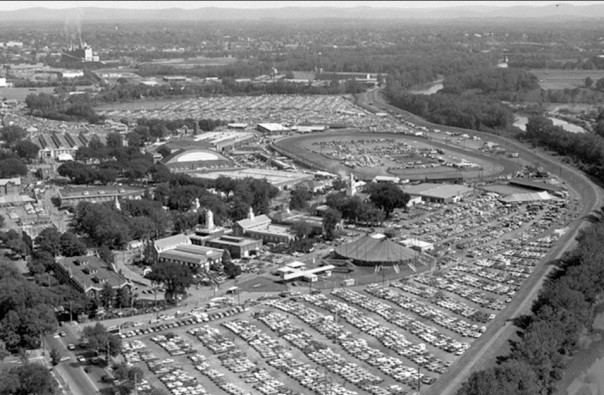
ESE fairgrounds by the river which can be seen to the far right beyond a berm. ESE archive image.
EXCERPT from The Field Illustrated System on The Farm 1921: “The National Dairy Show managed by W.E. Skinner, being the greatest event of the year in the dairy world, drew exhibitors and visitors from all over the country and made a fitting opening for the Eastern States Exposition grounds. The great educational value derived from this show had a lasting effect upon New England agriculture. The wonderful exhibit of cattle was an incentive to all breeders who visited the show and accomplished one of the aims of the Exposition management that of awakening the Easterners to the necessity for improved livestock and increased production. There is no official record of attendance at this first show, but on two of the days more than 45,000 people entered the grounds. … The exposition in 1920 broke all records with 2,000 entries in the various livestock departments and an attendance of 246,000. The premium list totaling $76,000 was especially attractive.”
Home and Field reported: “No better location could have been selected in New England than these grounds for Springfield is the center of agricultural activities in the northeastern section of the country. Springfield has another fact to recommend it as an ideal sight for such a venture. Within a radius of 150 miles of this city there are more people than at any similar point in the United States. The plant is served adequately by trolleys and is easily accessible by motor from any section. Upon the completion of the new $6,000,000 bridge across the Connecticut River that is now being built, a boulevard will lead direct to the grounds and bring the plant within seven minutes walk of the Union Station in Springfield.”
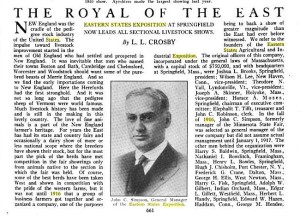
“The Royal of The East” headline is what this publication proclaimed of Eastern States Exposition in 1921.

Cattle judging contest at Eastern States Fair, 1936. Source: Farm Security Administration collection, Library of Congress Prints and Photographs Division.
“Westinghouse, the Nash Motor Car Company, Rolls Royce – they would all be here and would show their wares,” said Cassidy. “Each wanted to attract new employees and to promote people getting into the the machine tool industry. General Electric and Westinghouse released their latest new home appliances at the fairgrounds. Young Mr. Brooks was a powerhouse at attracting large manufacturers. Large fairs served as a gathering spot for the homemaker, the farmer, the industrialist – all could look around to see what's new.”
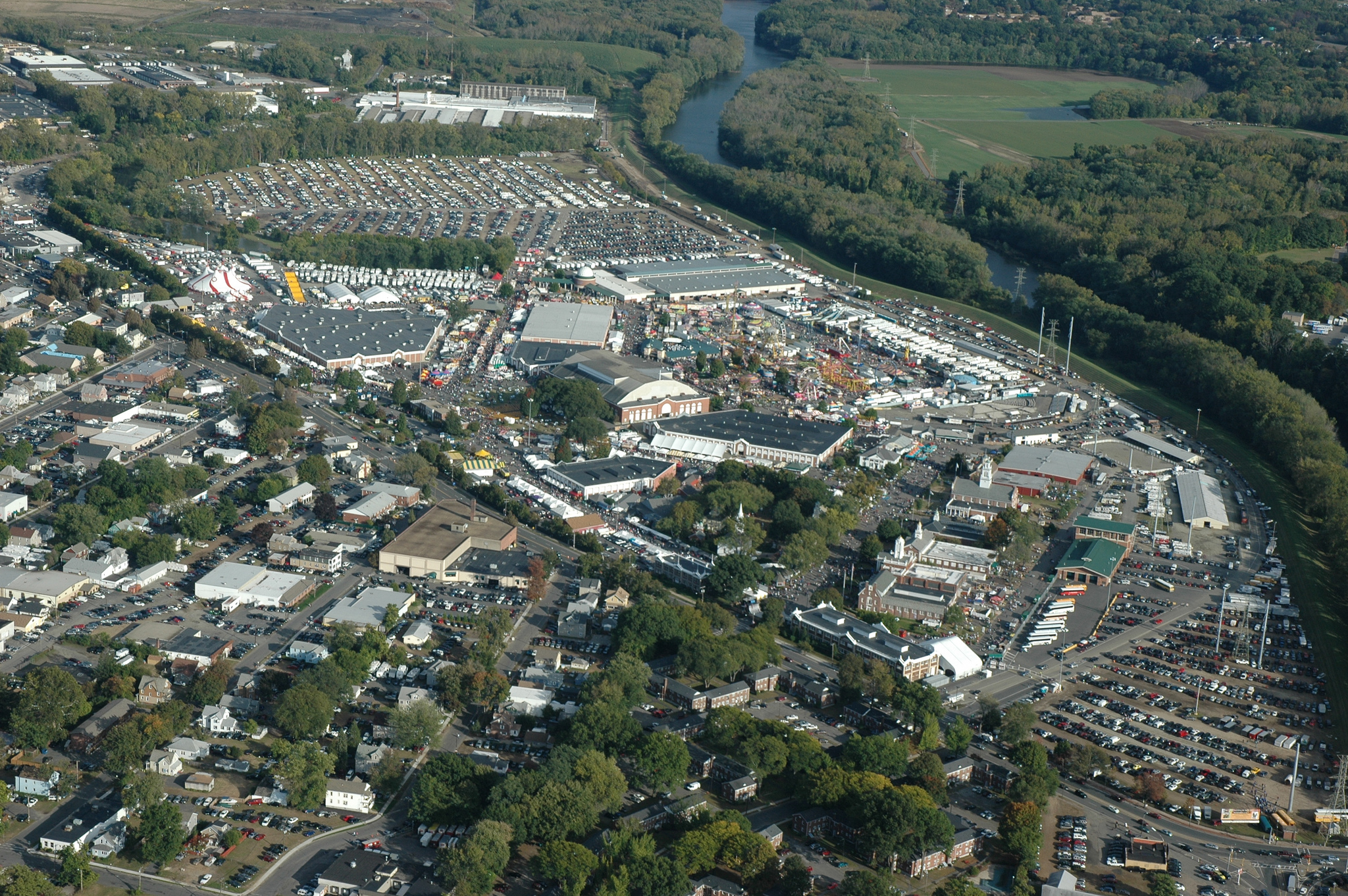
A more recent aerial view of the exposition fairgrounds and river taken during The Big E. Some 100 other events happen here – year round. ESE photo.
Now around 1918, each of the six New England states was “given property on the campus of Eastern States so they could erect a facsimile building of their original state house.”
For Brooks, this involved a big sales pitch.
“So how was he going to convince Maine, for example, to invest in a beautiful edifice that was reminiscent of their statehouse? He conceived of the buildings on the grounds as ‘incubators for business' – those were his words in 1918,” said Cassidy. “That term wasn't known – not until the '80s and the '90s did talk anyone talk about ‘incubators' regarding business. By 1923, Mr. Brooks had convinced all the people who had invested and bought shares in this for-profit organization to give him his shares back. Most did, some he had to purchase back.”
“Everything we do is directed at supporting the propagation of agriculture and industry,” said Cassidy, who is trained as an accountant, but admits that he loves people. In 1993 he served as ESE executive vice president and chief operating officer before becoming president and chief executive officer in 2012. Cassidy serves on a number of boards for leaders in both education and business as well as with being a certified fair executive of the International Association of Fairs and Expositions as a member of the IAFE Budget and Finance Committee.
Much like a flower draws a pollinator with nectar, color, and/or scent – a fair, large or small, has to draw people to the event. Once there, curiosity, food aromas, novelty, curiosity, experiences to be had – will do the rest.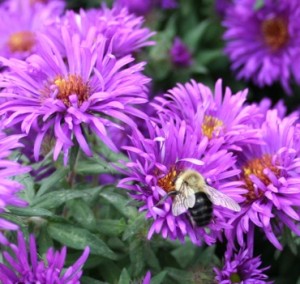
“People are attracted by food and entertainment, the glitz and bright lights and rides – all that is so that we can produce world-class agricultural events. By and large, most fairgoers probably never get to the cattle barns. But those ESE blue ribbon-winning cattle then go on to compete in Louisville, Kentucky, at the North American International Livestock Exposition.”
Which most fairgoers probably have never heard about either. The North American International Livestock Exposition (NAILE) is the world's largest all-breed, purebred livestock exposition. Along with it is the North American Quarter Horse Show, one of the largest shows in the nation and the North American Championship Rodeo with circuit finals for the Pro Rodeo Cowboys Association (PRCA). And that's just one facet of the ESE's interconnected world of livestock, people, companion animals and competitions.
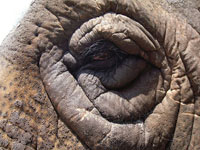 The Eastern States Exposition is a 365-day a year organization that also hosts an annual event known as The Big E or New England Fair – where six states participate and also hold the plot of land on which a replica of their statehouse stands. The original intent of its innovative and far-seeing founder still holds – to bring together agriculture and industry and let people see new, exciting and fresh ideas – then take those home with them. Yes, there's controversy at times. So what's at the heart of this corporation? Read on, in part two.
The Eastern States Exposition is a 365-day a year organization that also hosts an annual event known as The Big E or New England Fair – where six states participate and also hold the plot of land on which a replica of their statehouse stands. The original intent of its innovative and far-seeing founder still holds – to bring together agriculture and industry and let people see new, exciting and fresh ideas – then take those home with them. Yes, there's controversy at times. So what's at the heart of this corporation? Read on, in part two.

